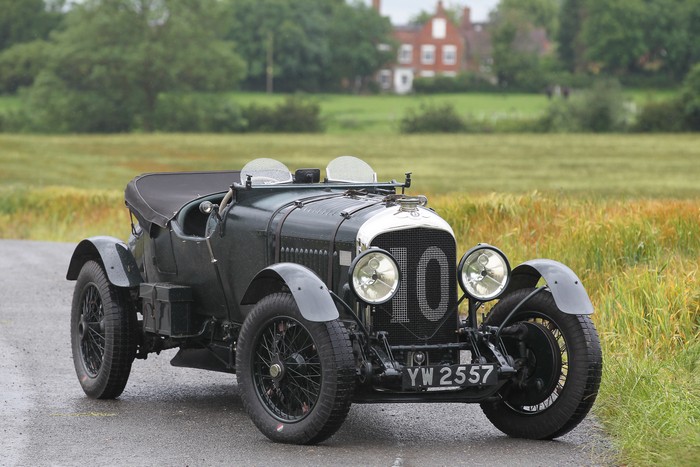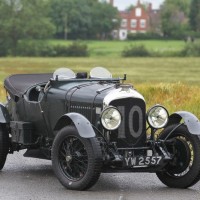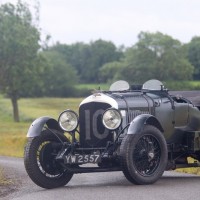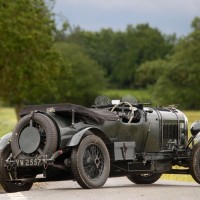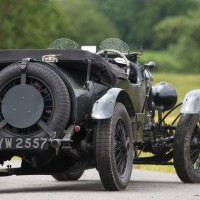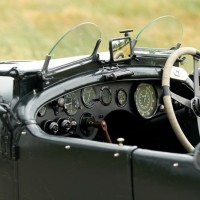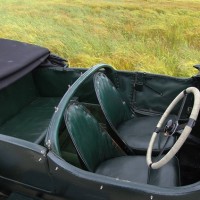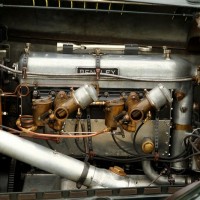SCM Analysis
Detailing
| Vehicle: | 1928 Bentley 4½ Litre Le Mans Sports “Bobtail” |
| Years Produced: | 1928 |
| Number Produced: | 4 |
| Original List Price: | N/A |
| Tune Up Cost: | $2,000 |
| Chassis Number Location: | Engine compartment on firewall |
| Engine Number Location: | Stamped on block |
| Club Info: | Bentley Drivers Club Ltd. |
| Website: | http://www.bdcl.org |
This car, Lot 20, car sold for $6,050,000, including buyer’s premium, at Gooding & Company’s Pebble Beach sale on August 18, 2012.
What a summer for proper vintage Bentleys. Those fortunate enough to have driven a factory-Works Bentley will know that the visceral experience is unlike any other pre-war sporting car.
“The world’s fastest lorries,” Ettore Bugatti called them, but they are indisputably quick. In comparison with a standard production chassis, the team cars have, as the catalog put it, “a momentous energy and lightness about them.” Vintage Bentleys all get down the road well with their massive torque from low-compression, long-stroke engines, but the team cars are almost uncannily fast.
The best of what’s left
Chassis KM3088 is one of the best left in the world — as is more usual for significant cars, it’s normally identified by its registration YW2557 (English registrations stay with their cars for life, unless you jump through various hoops to change them). It’s one of the few (almost) unmolested factory team cars still with its original Vanden Plas body. (Mother Gun, the 1927 runner and 1928 winner, chassis ST3001, is now a Speed Six-engined streamlined single-seater known as the Bentley-Jackson Special, following much development in its post-Le Mans years, although it wears a brass plate engraved “Mother Gun” — just in case it’s not recognized.
Chassis KM3088 retains its original 4,398-cc engine block with period-correct major parts. In the hands of its current owner (since 2004), it was entrusted to Bentley specialist Richard Cresswell of VBE Restorations for a complete preservative restoration. This meant finding key components to put the car back to as near 1927 spec as possible, including the factory racing sump from Mother Gun, and a set of SU slopers stamped “KM spare” — the racing team’s extra set of carburetors for YV7263 or YW2557. VintageBentleys.org has photos taken in earlier years that show it with standard “upright” SUs.
The current wings are probably an approximation of what it wore in the day, as pictures from 1948 and earlier show a flatter, simpler style. It’s estimated to make around 150 horsepower, now driving through a non-original gearbox.
Luckily, it’s the block rather than the crankcase that carries the all-important original number MF3175. On a Bentley, the block includes the cylinder head; the crankcase is separate and the valves go in from the bottom. It’s fiddly, especially for valve seat works, but it negates the possibility of head gasket failure because there isn’t one.
Bentleys chopped and changed
The point these last few paragraphs are struggling to make is that, however much they try, none of these “original” Bentleys is quite as original as it appears. However, in Bentley circles “original” can have a slightly looser interpretation, as these are some of the most famously chopped and changed vintage cars in the world — even by the factory.
As we saw last month (September 2012, English Profile, p. 48), the Birkin single-seater had worn a different body for a time before being put back to something approximating the car that Birkin vacated, and Mother Gun is unrecognizable as the 1927 Vanden Plas-bodied Le Mans racer. Nevertheless, we must take this as one of the most “original” as they come, and that is where its value lies.
The body retains period-correct fabric covering, with the VDP number stamped in the original body, and Works-specific hardware, components and modifications are found throughout the entire car.
For example, mounting brackets for the 1928 Le Mans third center headlamp remain on the front cross member. Other unique details on team cars included quick-release caps for water, fuel and oil replenishment, a leather hood strap, a fold-flat front screen, Aeroscreens, large-diameter gauges, bucket-style seats and cycle fenders.
The differences between the Works cars and the production cars amounted to innumerable modifications, either for weight savings, reliability or performance. Specifically for the 1928 Le Mans, the team cars sported a third, centrally mounted headlamp.
Original survivors bring the money
This car was sold by Christie’s at Le Mans in 2004 into its most recent ownership (of a Bentley Drivers Club member) for $2,023,065, pre-restoration when it was quite scruffy in 3- condition (SCM# 34914).
Now it has sold again — slap-bang in the middle of the $5.5m–$7.5m estimate range — and we can see how the market has valued original survivors in the eight years since, as the price has more than tripled. 4½s re-bodied into Le Mans style but with no Works history have been fetching up to $850,000, so the market considers the real thing to be worth around eight times as much — although you might have expected it to do a little better than the Birkin “Blower” single-seater that sold the month before in England.
Why? This car has proven Le Mans history (twice); it was a factory team car, which the Birkin car never was, and it is arguably as “original” — there we go again. Perhaps the difference is that there was only ever one supercharged single-seater in period, or maybe it’s just down to Retail Red. The market is a fickle thing. Well bought and well sold. ?
(Introductory description courtesy of Gooding & Company.)
